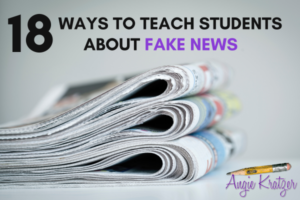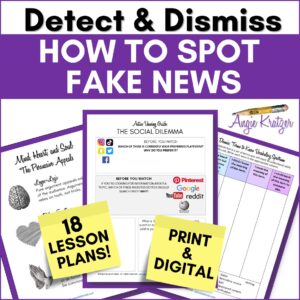
Fake news activities for high school students are in HIGH demand because the ability to recognize fake news requires a complex skill set. The brain has to develop a fine filter that can sift through sponsored content that doesn’t look sponsored, bias that disguises itself as balance, and interpretation that looks like facts.
For an educated, rational adult, this filter is at work. For a hormonal, irrational teenager who thinks “reality television” is reality, there is no screen. If it’s online, it must be true. As teachers, we have to help our students develop that filter, that ability to evaluate quickly whether an article in worth reading, much less believing. They need to recognize these five types of tricky “news” as described on CNN.com:
Fake news
These are the easiest to debunk and often come from known sham sites that are designed to look like real news outlets. They may include misleading photographs and headlines that, at first read, sound like they could be real.
Misleading News
These are the hardest to debunk because they often contain a kernel of truth: A fact, event or quote that has been taken out of context. Look for sensational headlines that aren’t supported by the information in the article.
Highly Partisan News
A type of misleading news, this may be an interpretation of a real news event where the facts are manipulated to fit an agenda.
Clickbait
The shocking or teasing headlines of these stories trick you into clicking for more information — which may or may not live up to what was promised.
Satire
This one is tough because satire doesn’t pretend to be real and serves a purpose as commentary or entertainment. But if people are not familiar with a satire site, they can share the news as if it is legitimate.
Those five types could be lesson plans in and of themselves, but a more scaffolded approach might be needed. This series of 18 lessons will prep students with the language of fake news before focusing on the motives of its creators.
◈Lesson 1: The Problem
Students learn relevant terminology and apply it to an article about students’ inability to distinguish the real from the fake.
◈Lesson 2: Headlines and Sponsored Content
Students learn to analyze the language of headlines and evaluate sites based on native ads and other sponsored content.
◈Lesson 3: Spin
Students compare and contrast how different outlets present and interpret facts.
◈Lesson 4: Hoax Sites and Satire
Students study the characteristics of sites designed specifically to reate fake news for different purposes.
◈Lesson 5: Reliability and Bias
Students learn to use the Media Bias Chart to evaluate reliability and bias.
◈Lesson 6: Loaded Language and Faulty Reasoning
Students learn to look for emotional, charged language and logical fallacies.
◈Lesson 7: Disinformation vs. Misinformation
Students learn the difference between disinformation and misinformation and the intent behind them.
◈Lesson 8: Artificial Intelligence
Students learn tips and tricks for identifying artificially-produced images and text.
◈Lesson 9: Video Manipulation
Students learn the ways videos are manipulated to deceive.
◈Lesson 10: Deep Fakes and Photoshop
Students are exposed to deep fakes and Photoshop and the way they are used to deceive audiences.
◈Lesson 11: Bots and Trolls
Students learn what bots and trolls are and how they work to spread false information and narratives.
◈Lesson 12: Social Media Algorithms
Students watch and analyze the Netflix film The Social Dilemma.
◈Lesson 13: Fact Checking and Source Tracking
Students learn to trace the original source of information and check the facts contained within it.
◈Lesson 14: Going Upstream & Lateral Reading
Students learn to do “upstream” research to track the origin of a story
and lateral research to discover information about a downstream publisher.
◈Lesson 15: Context
Students learn to analyze the context of a fact to make decisions about veracity.
◈Lesson 16: Misleading Graphs & Statistics
Students learn to evaluate graphs and statistics to detect deception and manipulation.
◈Lesson 17: Polls
Students learn to evaluate polls based on a set of criteria.
◈Lesson 18: Culminating Project
Students complete one of three projects in order to demonstrate their learning or extend their knowledge. Each student may create an infographic, create and track a fake news story, or research the consequences of fake news.
FEATURED RESOURCE
If you don’t want to start from scratch, this eighteen-lesson unit may work for you. It follows the process recommended above and includes the needed links and graphic organizers. All materials are on Google Slides as well for easy sharing with students.

Read more about this resource.
Looking for ways to teach logical fallacies? Get this discovery organizer and have students make meaning for themselves.


